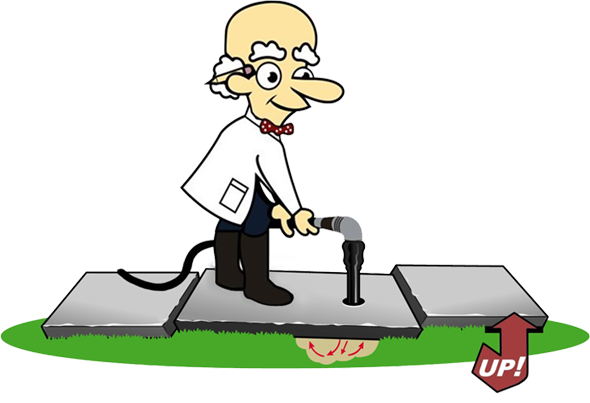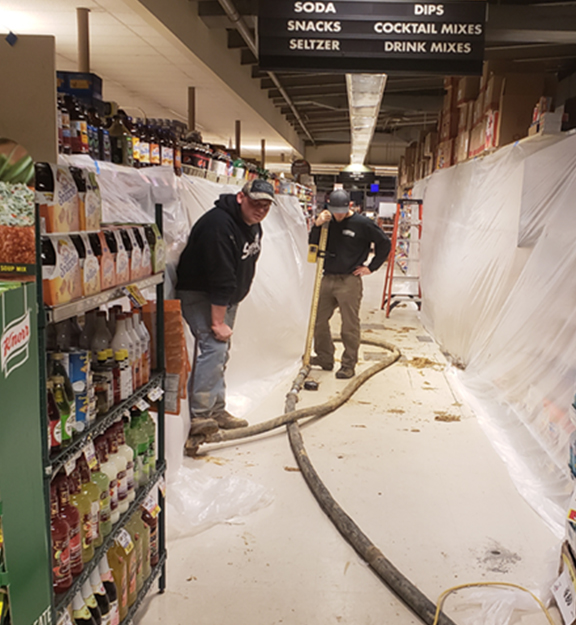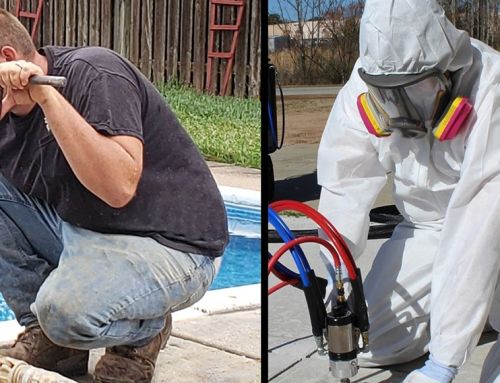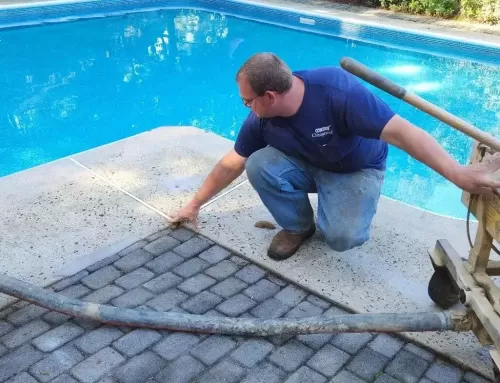IN THIS ARTICLE
What is mudjacking?
Mudjacking, also known as slab jacking or concrete leveling, is a process used to repair sunken or uneven concrete slabs, such as those found in sidewalks, driveways, or basement floors.
In this process, a mixture of water, soil, and cement is injected underneath the sunken concrete slab through small holes drilled into the surface. The injected mixture, also called “slurry”, fills the voids under the slab, effectively lifting it and leveling it with surrounding slabs.
Once the slab is level, the holes are patched with cement, and the slab is allowed to cure for a few days before being used again. Mudjacking is a cost-effective alternative to completely replacing sunken or uneven concrete slabs.
How does mud jacking work?
Mudjacking is a process that involves lifting sunken or uneven concrete slabs back to their original position by injecting a slurry mixture underneath them.
Here are the steps involved in the mud-jacking process:
- Drill Holes: Small holes, typically 1” inch in diameter, are drilled into the sunken concrete slab.
- Prepare Slurry: A slurry mixture is prepared by combining a cement-based grout with water and other additives.
- Inject Slurry: The slurry mixture is injected under the slab through the drilled holes. As the slurry fills the voids under the slab, it lifts the slab back to its original position.
- Fill Holes and Cure: Once the slab has been lifted to the desired height, the holes are filled with cement, and the slab is left to cure for a few days.
After the mud-jacking process, the concrete slab is restored to its original level, providing a stable and safe surface for use. Mudjacking is a cost-effective alternative to completely replacing sunken or uneven concrete slabs.
When is mudjacking necessary?
Environmentally friendly: Mudjacking uses a cement-based mixture that is non-toxic and environmentally friendly, making it a safe choice for people and pets.
Overall, mudjacking is a cost-effective, efficient, and long-lasting solution for repairing sunken or uneven concrete slabs, and it offers several advantages over other repair methods.
How long does mudjacking last?
The longevity of mudjacking depends on various factors such as the condition of the concrete, the quality of the mudjacking material used, and if the disturbed soil base has completed the settlement process.
On average, mudjacking can last for several years, with a history of jobs lasting 20 years or more. However, some factors can affect the lifespan of the mudjacking. For example, if the concrete slab was damaged due to poor soil compaction or inadequate support, the problem may reoccur and require additional mudjacking.
Additionally, the quality of the mudjacking material and the skill of the contractor can also affect the longevity of the repair. High-quality mudjacking material and a skilled contractor can help ensure the repair lasts for a long time.
Overall, the lifespan of mudjacking can vary depending on various factors, and it’s best to consult with a professional contractor to get a better idea of the expected longevity of a specific mudjacking project.
How much does mudjacking cost?
The cost of mud jacking can vary depending on various factors such as the location, the extent of the damage, the size of the area to be repaired, and the company performing the service. However, on average, the cost of mudjacking based on your area can have a typical range from $500 to $2,500 for a typical residential project, with some larger projects reaching a higher cost. Mudjacking will typically cost one third to half the cost of concrete replacement.
It’s important to note that these figures are just estimates and actual costs may vary significantly based on location and the specific circumstances of the job. To get an accurate estimate for your particular project, it’s best to contact a few local mudjacking.
Concrete replacement involves removing the damaged or sunken concrete and pouring new concrete in its place. This process is more time-consuming and expensive than mudjacking.
Generally speaking, if the damage is minor and the concrete is in good condition, mudjacking is a cost-effective and efficient solution. However, if the concrete is severely damaged or has significant structural issues, concrete replacement may be necessary.
In summary, whether mudjacking or concrete replacement is better depends on the specific situation. It’s recommended to consult with a professional contractor to determine the most suitable option for your needs.
How soon can I use the concrete after mudjacking?
The time required to use the concrete after mudjacking depends on several factors, such as the size of the repair, the weather conditions, and the type of mudjacking material used.
Typically, you can start using the concrete immediately after mudjacking. However, it’s essential to follow the specific instructions provided by the mudjacking contractor, as they may recommend a longer curing for vehicle traffic.
In cold weather, the curing time may be longer. Conversely, in hot and dry conditions, the curing time may be shorter.
Your mudjacking contractor can provide guidance on the weight limits and precautions to take during the curing period.
Is mudjacking a messy process?
It is typically less messy than some of the alternative methods for repairing concrete, such as removing and replacing the entire slab.
Mudjacking companies are typically able to control the mess by using specialized equipment and techniques to minimize the amount of mud and debris that is spread around the work area.
Overall, while there may be some mess associated with the mudjacking process, it is generally a relatively clean and efficient way to repair sunken concrete slabs.
How can I find a reliable mudjacking contractor?
Finding a reliable mudjacking contractor can be a challenging task, but here are some tips to help you out:
Look for licensed and insured contractors: Check if the contractor you are considering is licensed and insured. A licensed contractor has met the requirements for training and experience in mudjacking. Insurance coverage will protect you in case of any accidents or damage during the project.
Ask for referrals: Ask your friends, family, and neighbors for referrals. If they have had a good experience with a mudjacking contractor, they can recommend them to you.
Check online reviews: Check online reviews from previous customers to see if the contractor has a good reputation. Check review sites like Yelp, Google My Business, and Angie’s List. A contractor with a long business history will maintain mostly positive reviews. The online review process has become the number one tool in selection of quality contractors.
Check their experience: Ask the contractor how long they have been in business, and if they have experience working on projects similar to yours.
By following these tips, you can find a reliable mudjacking contractor who will provide quality work and excellent service.
Are there any risks involved with mudjacking?
Yes, there are certain risks involved with mudjacking, although they are typically minimal and can be mitigated but not eliminated with proper precautions. Risks include potentially forming a crack in the concrete slab which will typically remain hairline, or damage to surrounding areas such as pool coping.
To mitigate these risks, it’s important to choose a reputable and experienced mudjacking contractor who uses proper equipment and techniques.
What should I expect during the mudjacking process?
Evaluation: The first step is to evaluate the area to determine the cause of the unevenness and identify any potential issues that may need to be addressed before beginning the process.
Drilling: Once the evaluation is complete, small holes are drilled into the concrete slab to allow access to the voids beneath the surface.
Injection: A mixture of water, cement, and soil is injected into the holes using a high-pressure pump. This mixture, also known as slurry, fills the voids beneath the surface and lifts the concrete slab.
Leveling: As the slurry is injected, the concrete slab is lifted to the desired level. The process is carefully monitored to ensure that the slab is level and even.
Patching: Once the process is complete, the access holes are patched with a cement mix.
Cleanup: Finally, the work area is cleaned up, and any excess slurry or debris is removed.
Overall, mudjacking is a relatively quick and straightforward process that can be completed in a matter of hours, not days, depending on the size of the area. It’s a cost-effective way to repair uneven concrete surfaces, and the results can last for many years.
Will mudjacking raise my property value?
In general, if mudjacking improves the safety and functionality of your property, it could potentially prevent property devaluation and increase its value. For example, if your sunken driveway is causing water to pool and creating a safety hazard, mudjacking could make the property safer and more functional, thereby increasing its value.
Settled concrete can diminish property resale value, delay home sales, and cause insurability and liability issues for property owners.
Is mudjacking a permanent solution for sunken concrete?
Mudjacking can be an effective solution for sunken concrete in many cases, however, the underlying cause of the sinking must be addressed. If the cause of concrete settlement has not been addressed, the concrete may continue to settle over time.
For example, if the sinking is caused by soil erosion or shifting soil, mudjacking may lift the concrete, but if the soil continues to erode or shift, the concrete may sink again. In such cases, additional mudjacking may be necessary in the future.
A proper assessment to determine the number of years since the based soils were disturbed is an important part of the evaluation process.
That being said, if the cause of the sinking concrete is properly addressed, and the concrete raising process is performed by a qualified and experienced professional, it can provide a long-lasting solution for sunken concrete.
DIY mudjacking be done or is it better to hire a professional?
While DIY mudjacking can be done, it’s generally better to hire a professional for this task.
Mudjacking requires specialized equipment, such as a pump, proper truck, drill, that can be expensive to purchase. In addition, the process requires a certain level of skill and knowledge to ensure that it’s done correctly and safely. Without the proper equipment and knowledge, there is a risk of damaging the concrete slab or creating further problems.
Hiring a professional mudjacking contractor will ensure that the job is done correctly and efficiently. They will have the necessary equipment and expertise to assess the situation and determine the best course of action to fix the problem. Additionally, most contractors offer a warranty on their work, so if there are any issues after the mudjacking is done, they will come back and fix the problem. Overall, while it is possible to do DIY mudjacking, it’s generally better to hire a professional to ensure that the job is done correctly and safely.
Is there a warranty for mudjacking?
The warranty against concrete raising settlement can vary depending on the contractor or company you hire to perform the service. Some contractors may offer a warranty for their work, while others may not. If a contractor offers a warranty, it typically covers the workmanship and materials used for a certain time period.
It is important to look at a warranty against ground movement and concrete settlement logically as ground movement can occur if the soil based is only a few years old and has not fully settled, soil erosion due to poor drainage, or a yearly freeze thaw cycle.
As with concrete replacement and other services which typically offer a one-year warranty, a concrete raising contractor should offer a similar warranty. While you may come across companies that offer a 5 year, 10 year, or lifetime warranty during their “sales” process, the warranty is only as good as the company that is backing it, so these warranty claims can be easily be validated by asking for references in which the company returned “10 years” after to warranty their work. This will reduce the possibility of you choosing your contractor based on false claims at the time of sale.
It’s important to ask any potential contractor about their warranty policy before hiring them to perform mudjacking. Additionally, be sure to read the terms and conditions of the warranty carefully to understand what is covered and what is not.
- Mudjacking Cost: 5 Factors That Affect It - April 10, 2024
- What is The Average Cost of Concrete Leveling in Belle Mead, NJ? - April 4, 2024
- Unveiling the Top Pool Deck Resurfacing Options: Choosing the Best for You - March 26, 2024







